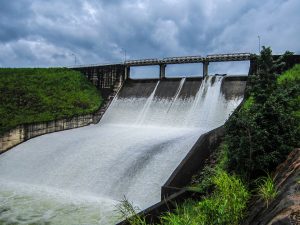
Is it possible to have a dam that contributes to the socioeconomic and energy needs of a community without degrading the surrounding environment?
Researchers from Arizona State University found the answer to this question. They wanted to observe how dams would impact the food security among communities around the Mekong River. Many of these communities rely on the river for their food source and employment. Nutritionally, rural fishing and agricultural communities receive animal protein and vitamin A from the river too. From their study, Results indicate that a design flow that mimics long inter-flood interval and short, strong flood pulses produced higher fish yields than from natural flow restoration. Their results are an extension of previous studies that linked the flood magnitude, duration, and a low period followed by short, strong flood pulses leaded to higher yields in fisheries.
Sabo and his co-authors based their study on the rivers in Lower Mekong Basin. The Mekong River is the twelfth largest in the world, estimating 4350 kilometers in length. It is also the eight largest river that discharges and hosts one of the largest inland fisheries in the world. The river goes through China, Myanmar (Burma), Laos, Thailand, Cambodia, Vietnam.
Due to its large presence across transnational boundaries, it has attracted hydro-power development. According to the researchers, hydropower is a common source of energy for poor, predominantly rural populations. Despite its alternative benefits as a renewable energy, the process could have negative impacts on the environment. For instance, hydrologic alteration from dams could lead to invasion of non-native aquatic species, which would impact the food web structure.
To analyze the relationship between food security and dams, the researchers evaluated the discharges on the Tonle Sap River that connects the Mekong River to the Tonle Sap Lake . The Dai fishery is located on this river too. The Dai fishery has a nursery habitat that houses approximately 300 fish species. In addition to the biodiversity, the fishery is the most valuable and productive (i.e. number of fish caught) in the Lower Mekong Basin according to the researchers.
Based on their results, designed flows had a 76% annual increases in yield compared to 47% in annual yield in natural flow restoration along the Tonle Sap and Mekong Rivers. Designed flows are based on models on flood pulse extent, based on flood magnitude and duration, and net annual anomaly, based on the sum of all positive (wetness) and negative (dryness) anomalies to detail annual discharges. Natural flow is based on the conditions of the water before the installation of dams. Currently, there are projected dams in China, Laos, and Cambodia that would allow water managers to control the flow of the river. This study suggests designed flows prompts higher yields, which would encourage more projects to make dams to insure food security. Below is an image of the proposed dams by the researchers that support the designed-flow model recommended by them.

Source:
Sabo J.L., Ruhi, A., Holtgrieve, G.W., Elliott, V., Arias, M.E., Bun Ngor, P., Rasanen, T.A., Nam, S. 2017. Designing river flows to improve foo security futures in the Lower Mekong Basin. Science 358: 1053.

Growing up in South Asia, the perils of flood faced by people due to mismanaged construction of damn was a very frequent happening. If this were plan were to work, it would be immensely beneficial for both humans and the environment.